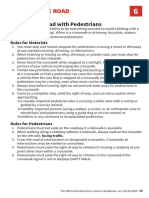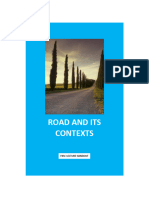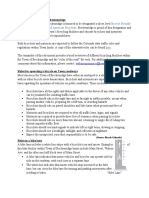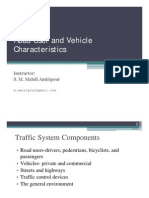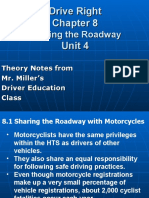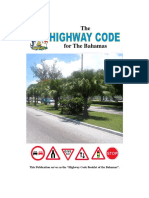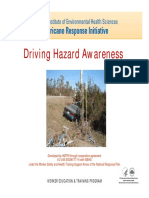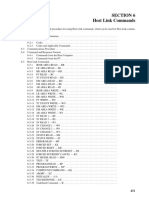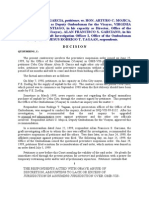Module 9 Sharing Road
Module 9 Sharing Road
Uploaded by
FunCopyright:
Available Formats
Module 9 Sharing Road
Module 9 Sharing Road
Uploaded by
FunOriginal Title
Copyright
Available Formats
Share this document
Did you find this document useful?
Is this content inappropriate?
Copyright:
Available Formats
Module 9 Sharing Road
Module 9 Sharing Road
Uploaded by
FunCopyright:
Available Formats
Please note that the driving school instructor may use a different presentation to teach this module.
Sharing the Road
PHASE 3 SEMI-GUIDED DRIVING 1
Outline of Module 9
• Activity: Improvisation on Sharing the Road
• Sharing the Road with Vulnerable Users
– Pedestrians, cyclists, moped and scooter operators,
motorcyclists, users of motorized mobility aids, etc.
• Sharing the Road with Heavy Vehicles
– Trucks, tractor-trailers, tractor semi-trailers, road trains,
intercity motorcoaches, city buses, school buses, emergency
vehicles
SHARING THE ROAD 2
Targeted Competencies
• Taking other road users into account
• Driving cooperatively and courteously
• Evaluating one’s behaviour with regard to sharing the road
• Anticipating potential at-risk situations
SHARING THE ROAD 3
Activity: Sharing the Road
Instructions (team of improvisers)
• Take 10 minutes to:
‒ Choose an improvisation card and prepare an improvisation
of not more than 4 minutes (refer to the lists of the main
characteristics of vulnerable users)
• During the improvisation exercise, consider the following:
‒ The characteristics of vulnerable users
‒ The Observe-Evaluate-Act (OEA) elements that drivers of a
road vehicle must apply in their presence
• Present your improvisation
SHARING THE ROAD 4
Activity: Sharing the Road (cont.)
• Instructions (the other teams)
– Appoint a spokesperson to report back to all participants
– Take 10 minutes to complete the Checklist for Sharing the
Road based on your current knowledge
– During the activity, you can flesh out the checklist with any
new elements you identify
SHARING THE ROAD 5
Checklist for Sharing the Road
Road User Main Observe Evaluate Act
Category Characteristics
What to Watch For What to Think About What to Do
SHARING THE ROAD 6
Sharing the Road with
Vulnerable Users
SHARING THE ROAD 7
Vulnerable Users
• Different types of vulnerable users
- Pedestrians, cyclists, moped and scooter operators,
motorcycylists, users of motorized mobility aids
• Characteristics
- Less well protected and more likely to be injured in a
collision
• Remember
- Pay special attention to them
- Maintain adequate safety margins
SHARING THE ROAD 8
Pedestrians
• Often difficult to see, especially in the evening and at
night
• Most at risk are child pedestrians and seniors
• Approximately 3,000 pedestrians are killed or injured
every year in Québec
SHARING THE ROAD 9
Pedestrians: Characteristics
• Children • Seniors and disabled
– Small persons
– Often absent-minded and – More fragile physically
impulsive – Get around more slowly
– Unable to judge the speed of – Their faculties are
oncoming vehicles sometimes diminished
– Not always aware of danger
SHARING THE ROAD 10
Pedestrians: What to Watch For (Observe)
Urban area Rural area
• Scan sidewalks and • Watch along the sides of
intersections, particularly roads and highways
in residential areas and in
the vicinity of schools and
playgrounds
Pay special attention to children, seniors
and disabled persons
SHARING THE ROAD 11
Pedestrians: What to Think About (Evaluate)
• Be aware that
- Pedestrians may change directions or cross the street without
checking traffic or signalling their intentions
- Cars may hide the presence of children
- Seniors and disabled persons need more time to get from one
place to another
- Children can be unpredictable. They may
• cross the street between intersections
• suddenly appear from between parked cars
• cross the street without checking traffic
SHARING THE ROAD 12
Pedestrians: What to Do (Act)
• Obey road signs, traffic signals and traffic rules, particularly
when you must yield the right of way
• Reduce speed as required, particularly in residential areas
and in the vicinity of schools and playgrounds
• Make eye contact with pedestrians and use a hand signal or
a nod of your head to indicate that they can cross in front of
you
• Be patient and courteous
SHARING THE ROAD 13
Did You Know…
• Adult school crossing guards have the same powers as peace
officers
• Drivers who fail to obey the orders or signals of a school
crossing guard or a flag person are liable to a penalty
of 4 demerit points
SHARING THE ROAD 14
Cyclists
• Collisions between bicycles and road vehicles are responsible
for the majority of cyclist deaths, i.e. nearly 80%
• The same kind of accident also causes 20% to 25% of cyclist
hospitalizations
SHARING THE ROAD 15
Cyclists: Characteristics
• As a rule, they travel on the right side of the road
• They sometimes make sudden moves
• They are slower moving than road vehicles and can easily
weave in and out of traffic
SHARING THE ROAD 16
Cyclists: What to Watch For (Observe)
• Watch along the sides of the road
• Pay attention to cyclists’ hand signals
• Scan the road at intersections
• Do shoulder checks (blind spots) and check your mirrors
SHARING THE ROAD 17
Cyclists: What to Think About (Evaluate)
• Be aware that cyclists don’t always stay on the right side
of the road
• Be careful in the vicinity of cycling lanes and bicycle
paths
• Anticipate sudden moves by cyclists
SHARING THE ROAD 18
Cyclists: What to Do (Act)
• Obey road signs, traffic signals and traffic rules, particularly when
you must yield the right of way
• Use the left lane if there is not enough room to maintain the
mandatory safety margin between you and the cyclist
• Make eye contact, where possible
• Yield the right of way
– when driving into or out of a private driveway
– when making a turn
– at intersections
• Before opening the door of a stopped vehicle, make sure you can
do so safely
SHARING THE ROAD 19
Did You Know…
– Head injuries cause about 60% of cyclist deaths in
accidents
– In 2014, only 53% of cyclists wore a helmet, despite
numerous awareness campaigns over the years to
encourage their use
SHARING THE ROAD 20
Moped and Scooter Operators and Motorcyclists:
Characteristics
• They are entitled to the full width of the lane
• They sometimes make sudden moves
• They are less visible in road vehicle blind spots
• They are not protected by a passenger compartment
• It is difficult to judge their actual speed
SHARING THE ROAD 21
Moped and Scooter Operators and Motorcyclists:
What to Watch For (Observe)
– Scan intersections and the right-hand side of the road
– Do shoulder checks (blind spots) and check your mirrors
– Look for clues from the operator’s posture
SHARING THE ROAD 22
Moped and Scooter Operators and Motorcyclists:
What to Think About (Evaluate)
– Anticipate
• sudden moves
• lane positioning when they prepare to turn
• their presence in the vicinity of secondary schools
• braking fast, and short braking distance
– Take into account that it is difficult to judge the distance
between you and a moped, scooter or motorcycle, and to
estimate its speed
SHARING THE ROAD 23
Did You Know…
– Teens 14 to 16 years of age represent approximately 65%
of moped and scooter operators involved in accidents
– On average from 2014 to 2018, for every 10,000
motorcycles travelling on Québec’s roads,
105 motorcyclists were injured or killed
SHARING THE ROAD 24
Motorized Mobility Aids (MMAs):
Characteristics
– MMAs include electric wheelchairs, and three-wheeled and
four-wheeled scooters
– Not clearly visible at night (do not always have front or rear
lights or a flag)
– Fairly quiet, and therefore may not be heard when
approaching
SHARING THE ROAD 25
Motorized Mobility Aids (MMAs)
• What to Watch For (Observe)
– Pay attention to their movements
• What to Think About (Evaluate)
– Expect the behaviour of their users to be unpredictable
– Expect them to move from the sidewalk to the roadway and back
again without signalling their intentions
• What to Do (Act)
– Be careful when passing MMAs
SHARING THE ROAD 26
Sharing the Road with Heavy Vehicles
SHARING THE ROAD 27
Heavy Vehicles
• Different types
– Trucks, tractor-trailers, tractor semi-trailers, road
trains, intercity motor coaches, city buses, school
buses, snow removal trucks, emergency vehicles
(ambulances, fire trucks, police vehicles)
• Characteristics
– Many blind spots
– Much heavier and bigger than a car
– Longer braking distance
SHARING THE ROAD 28
Blind Spots
Front Rear Left Right
SHARING THE ROAD 29
Size and Weight
Maximum 4,500 kg
Maximum 59,000 kg
SHARING THE ROAD 30
Braking Distance
APPROXIMATE EMERGENCY STOPPING DISTANCE
Distance (metres)
TYPE OF VEHICLE 0 10 20 30 40 50 60 70 80 90 100
| | | | | | | | |
3-axle truck
22 metres
50 km/h
88 metres
(GVW 25,250 kg) 100 km/h
7-axle tractor semi-trailer
21 metres
50 km/h
84 metres
100 km/h
(GVW 55,500 kg)
Passenger vehicle
(Net weight 2,570 kg– Large vehicle) 9.5 metres
50 km/h
38 metres
100 km/h
SHARING THE ROAD 31
Flying Road Debris and
Road Spray
• Road Debris
– Objects can fly off trailers, tire treads can separate from tires and
stones can be thrown up by tires
• Road Spray and Reduced Visibility
– In poor weather, heavy vehicles can spray water and slush onto your
windshield, resulting in reduced visibility (driver’s trick: turn on your
windshield wipers before reaching a heavy vehicle)
SHARING THE ROAD 32
Heavy Vehicles Are Part of
Daily Life
SHARING THE ROAD 33
School Buses
• They make frequent stops to take on or drop off school
children
• They stop at level crossings
• Pay special attention to
• Alternately flashing yellow lights
• Yellow emergency or hazard lights
• Flashing red lights
• Stop arm
• Children near the vehicle
SHARING THE ROAD 34
Did You Know…
Passing a school bus when its flashing
red lights are activated
9 demerit points and
a fine of between $200 and $300
SHARING THE ROAD 35
City Buses
• They make frequent stops to take on or drop off
passengers
• They stop at level crossings
• Pay special attention to
– the bus as it merges back into its travel lane
– passengers near the city buses
SHARING THE ROAD 36
Did You Know…
Failing to yield the right of way to a bus that is signalling
to merge back into its travel lane
A fine of between $100 and $200
SHARING THE ROAD 37
Tractor Semi-Trailers
• This combination of vehicles composed of a semi-trailer
hitched to a road tractor is one of the largest vehicles on the
road
• Pay special attention to
– signalling by the vehicle
– signs on the tractor or the trailer(s)
SHARING THE ROAD 38
Tractor Semi-Trailers: Signs
• Vehicles transporting dangerous
substances are identified by
diamond-shaped signs (placards)
• Two types of rectangular signs identify road trains
• Outsized vehicles
SHARING THE ROAD 39
Emergency Vehicles
• Emergency vehicles include police and fire department vehicles,
ambulances and vehicles operated by utility companies
• Pay special attention to
– flashing lights
– sirens
SHARING THE ROAD 40
Emergency Vehicles
What to Do (Act)
• Yield the right of way
• Allow unhindered passage as soon as you hear a siren or see
flashing lights in your mirrors
• Safely free up the lane in which the emergency vehicle is
travelling and stop your vehicle, if necessary
• Leave a buffer lane between your vehicle and an emergency
vehicle, tow truck or surveillance vehicle that is stopped on the
roadway
SHARING THE ROAD 41
And Don’t Forget…
SHARE THE ROAD!
SHARING THE ROAD 42
You might also like
- Highway Code MalaysiaDocument10 pagesHighway Code MalaysiaSyafeena Insyirah100% (1)
- Kenya Learner Driver HandbookDocument84 pagesKenya Learner Driver HandbookaganoelmoegaNo ratings yet
- Method 1:: Steps To Flash The DCC Firmware On The M477/M452/M377 For The 59.F0 Error IssueDocument9 pagesMethod 1:: Steps To Flash The DCC Firmware On The M477/M452/M377 For The 59.F0 Error IssueAndrey Khodanitski100% (1)
- TDC-15-S-04 Defensive Driving and MV MaintenanceDocument105 pagesTDC-15-S-04 Defensive Driving and MV MaintenanceJoel Dignos Roa100% (3)
- Ntsa Private Light Vehicles Learner's Handbook 2017Document84 pagesNtsa Private Light Vehicles Learner's Handbook 2017EXPRESS DIGITAL HUB100% (1)
- Traffic On The Highway - Sharing The RoadDocument7 pagesTraffic On The Highway - Sharing The RoadS Lucian StefanNo ratings yet
- Sharing Roads and Paths Accessible Online Document 050713 FINALDocument3 pagesSharing Roads and Paths Accessible Online Document 050713 FINALTerry LollbackNo ratings yet
- Sharing The Road SafelyDocument18 pagesSharing The Road SafelyanjalibhatsNo ratings yet
- 6 - Sharing The RoadDocument8 pages6 - Sharing The RoadJorge LuizNo ratings yet
- TDC-15-S-07-3 Active Transport and Light Mobility VehicleDocument16 pagesTDC-15-S-07-3 Active Transport and Light Mobility VehicleSanty UyNo ratings yet
- Road and Its ContextDocument16 pagesRoad and Its ContextOLAYANJU OLATUNBOSUN DAMILARENo ratings yet
- Hazard Idendification Training ModuleDocument41 pagesHazard Idendification Training Moduleraymond paul adelantarNo ratings yet
- Road SafetyDocument48 pagesRoad SafetyHazel BustineraNo ratings yet
- Lane Splitting GuidelinesDocument5 pagesLane Splitting GuidelinesDamon LavrincNo ratings yet
- Looking Out For Your Safety: Seattle StreetcarDocument16 pagesLooking Out For Your Safety: Seattle StreetcarJustin CarderNo ratings yet
- Safe Driving PrinciplesDocument73 pagesSafe Driving PrinciplesLextor ElizaldeNo ratings yet
- DP Life Choices On The Road-eBookJune22Document36 pagesDP Life Choices On The Road-eBookJune22281410mari.bondNo ratings yet
- Secondary School PresentationDocument31 pagesSecondary School PresentationChantalNo ratings yet
- F9E6F71E-BE75-CAC9-F4A1-BF08E61B3F05Document1 pageF9E6F71E-BE75-CAC9-F4A1-BF08E61B3F05taieba59No ratings yet
- Defensive Drive. CourseDocument82 pagesDefensive Drive. CourseSubbarao MallampalliNo ratings yet
- Share Be Aware May11Document2 pagesShare Be Aware May11rociopatriciabeltranNo ratings yet
- Crash Types, WA 2000-2009: by Road MovementDocument3 pagesCrash Types, WA 2000-2009: by Road MovementAlisha D'souzaNo ratings yet
- Road Safety Syllabus Book For SECONDARY STUDENTSDocument34 pagesRoad Safety Syllabus Book For SECONDARY STUDENTSMichael Blunt100% (1)
- Bicycling The Town of Breckenridge Public Education 7-28-10Document4 pagesBicycling The Town of Breckenridge Public Education 7-28-10summitdailyNo ratings yet
- Lecture 2 - Road User and Vehicle CharacteristicsDocument31 pagesLecture 2 - Road User and Vehicle CharacteristicsMing QiNo ratings yet
- Drive SafelyDocument45 pagesDrive SafelyEHS_PlantIIINo ratings yet
- Rules of The Road : Ride On The RightDocument5 pagesRules of The Road : Ride On The RightDauntay McCannNo ratings yet
- National Safety Council Defensive Driving Course 4Document57 pagesNational Safety Council Defensive Driving Course 4Sylvia Donaldson100% (1)
- AmedoDocument38 pagesAmedoEnok IncursioNo ratings yet
- 67410aa672edf812e4f251d9 RofesixisidoxigobivDocument2 pages67410aa672edf812e4f251d9 RofesixisidoxigobivahmedkibenderaNo ratings yet
- Objectives: Defensive DrivingDocument81 pagesObjectives: Defensive DrivingLalit MakwanaNo ratings yet
- Tuurn This in Mudloe 6Document4 pagesTuurn This in Mudloe 6Colton HeathNo ratings yet
- Drivers 6Document33 pagesDrivers 6shijil.thomas22No ratings yet
- Providing For The Safety of Pedestrians and PWD:The Most Vulnerable Road UsersDocument35 pagesProviding For The Safety of Pedestrians and PWD:The Most Vulnerable Road UsersJames LaurentNo ratings yet
- Driving Hazard AwarenessDocument27 pagesDriving Hazard AwarenessMohammed Ahmed NasherNo ratings yet
- Bicycle: Rules of The RoadDocument12 pagesBicycle: Rules of The RoadMaria TudorNo ratings yet
- RTD Highway Code PDFDocument92 pagesRTD Highway Code PDFJeffrey Michael ChiwaulaNo ratings yet
- Road Safety PresentationDocument15 pagesRoad Safety PresentationNandi Sujay100% (1)
- Defensive DrivingDocument76 pagesDefensive DrivingJefferson Rochester ReyesNo ratings yet
- Roundabout GuideDocument8 pagesRoundabout GuideWatertown Daily TimesNo ratings yet
- Road Safety Answers 2Document6 pagesRoad Safety Answers 2Chandan Tendu100% (1)
- Drivers Theory ExamDocument28 pagesDrivers Theory ExamAllexes DuncombeNo ratings yet
- RoadSense For Riders See Think Do MV2076Document23 pagesRoadSense For Riders See Think Do MV2076Kimball FiniganNo ratings yet
- Cycle Safety BookletDocument12 pagesCycle Safety Bookletapi-308565458No ratings yet
- Presentation Name: Pedestrians Safety in Road Traffic: Group MembersDocument14 pagesPresentation Name: Pedestrians Safety in Road Traffic: Group MembersMaxamed YusufNo ratings yet
- Care and Vigilance Save Lives!Document0 pagesCare and Vigilance Save Lives!ccspaghettiNo ratings yet
- Highway Code EN - PDF - 20130927083609 PDFDocument90 pagesHighway Code EN - PDF - 20130927083609 PDFBG100% (1)
- Module 6 Worksheet by Gavin HardimanDocument4 pagesModule 6 Worksheet by Gavin HardimanGavin Hardiman100% (1)
- Driver Ed Final Exam ReviewDocument22 pagesDriver Ed Final Exam Reviewadriangsanders12No ratings yet
- Traffic Management: Occupational Safety and Health (MGT 61003) Presentation 1Document53 pagesTraffic Management: Occupational Safety and Health (MGT 61003) Presentation 1Ahmad AliNo ratings yet
- Convoy Driving and Executive ProtectionDocument28 pagesConvoy Driving and Executive ProtectionAnonymous pOggsIhOMNo ratings yet
- Top Five Misunderstood Road RulesDocument24 pagesTop Five Misunderstood Road RulesSebastian KilmartinNo ratings yet
- Defensive Driving: Training For DriverDocument31 pagesDefensive Driving: Training For DriverUwol SanchezNo ratings yet
- Niehs Driving Hazard AwarenessDocument27 pagesNiehs Driving Hazard Awarenessn.hartonoNo ratings yet
- Cycle Safety Visibility LeafletDocument2 pagesCycle Safety Visibility LeafletPhyllis StephenNo ratings yet
- DDS - DavbDocument138 pagesDDS - Davbjovy.gagabuan001No ratings yet
- Pedestrian Road Layout: Reported By: Parot, John Micko JDocument23 pagesPedestrian Road Layout: Reported By: Parot, John Micko JJohn MickoNo ratings yet
- Guyana Road Traffic CodeDocument42 pagesGuyana Road Traffic CodeJ-Den MoffattNo ratings yet
- Bicycling 1,100 Best All-Time Tips: Top Riders Share Their Secrets for Maximizing Performance, Safety, and FunFrom EverandBicycling 1,100 Best All-Time Tips: Top Riders Share Their Secrets for Maximizing Performance, Safety, and FunRating: 2 out of 5 stars2/5 (1)
- Bhel HaridwarDocument27 pagesBhel HaridwarSandeep Kumar100% (1)
- Navigate Unit 4Document36 pagesNavigate Unit 4ly_narci380No ratings yet
- Project Proposal MPMDocument19 pagesProject Proposal MPMWAN SYIFA� HANANI BINTI MOHD HAFIZ Pelajar KPTM IpohNo ratings yet
- ChE 154 Lecture 1Document35 pagesChE 154 Lecture 1a3kt95No ratings yet
- Section 6 Host Link CommandsDocument35 pagesSection 6 Host Link CommandsvitexNo ratings yet
- Method Statement For PipesDocument75 pagesMethod Statement For Pipesxander1982No ratings yet
- Subhasri ResumeDocument1 pageSubhasri ResumeShaik AbdulrajaqNo ratings yet
- 2011 Kia SportageDocument3 pages2011 Kia SportagearielsobarzomatamalaNo ratings yet
- Factors Affecting Online Streaming Subscriptions: October 2018Document26 pagesFactors Affecting Online Streaming Subscriptions: October 2018api-583156298No ratings yet
- Critical Thinking and Creative Thinking - The Self-Assessment of Algebra StudentsDocument13 pagesCritical Thinking and Creative Thinking - The Self-Assessment of Algebra StudentsTihana BabicNo ratings yet
- Chapter One Fundamentals of Assurance Services I. The Concept of AssuranceDocument11 pagesChapter One Fundamentals of Assurance Services I. The Concept of AssuranceJeremy Lorenzo Teodoro VirataNo ratings yet
- Laporan Harian 11 Juli 2018Document8 pagesLaporan Harian 11 Juli 2018Syukron Khotibul UmamNo ratings yet
- 94 Prof Moeller Summary enDocument18 pages94 Prof Moeller Summary enaptureincNo ratings yet
- Lecture 8 Standardization PDFDocument42 pagesLecture 8 Standardization PDFJakes ValNo ratings yet
- UPSC Mains - General Studies. by Nitesh Patil, IASDocument2 pagesUPSC Mains - General Studies. by Nitesh Patil, IASAbhishek Kumar Jha100% (1)
- New Project PPT FormatDocument16 pagesNew Project PPT FormatHarsh GamingNo ratings yet
- A Scoping Review of Market Links Between Value Chain Actors and Small-Scale Producers in Developing RegionsDocument16 pagesA Scoping Review of Market Links Between Value Chain Actors and Small-Scale Producers in Developing RegionsDavid CastelloNo ratings yet
- Trainer Kit Tamilnadu MailDocument10 pagesTrainer Kit Tamilnadu MailBiswanath LenkaNo ratings yet
- CDN Enhancement Laboratory and Lectures Summaries and QuizDocument57 pagesCDN Enhancement Laboratory and Lectures Summaries and QuizDroffelg ZednemNo ratings yet
- BS 7863 1996 Fire Extinguisher ColoursDocument10 pagesBS 7863 1996 Fire Extinguisher ColoursPradeep NairNo ratings yet
- Techverse PlanDocument26 pagesTechverse PlanĐức VũNo ratings yet
- Facts: Sadhana Nabera V. SebiDocument6 pagesFacts: Sadhana Nabera V. SebiPrajakta JoshiNo ratings yet
- General HandDocument4 pagesGeneral HandWalter tawanda MusosaNo ratings yet
- IntralotDocument6 pagesIntralotEric BoroianNo ratings yet
- Sodium and Potassium Silicates Brochure ENG Oct 2004Document16 pagesSodium and Potassium Silicates Brochure ENG Oct 2004Lekhamani Yadav0% (1)
- Alvin Garcia Vs MojicaDocument11 pagesAlvin Garcia Vs MojicaKay AvilesNo ratings yet
- Managing Human Resources: Neta Powerpoint PresentationsDocument23 pagesManaging Human Resources: Neta Powerpoint PresentationsAjay BediNo ratings yet
- ACR On Food SafetyDocument4 pagesACR On Food SafetyMaitem Stephanie GalosNo ratings yet
- 1st Exam DigestsDocument171 pages1st Exam DigestsKirsten Rose Boque ConconNo ratings yet








